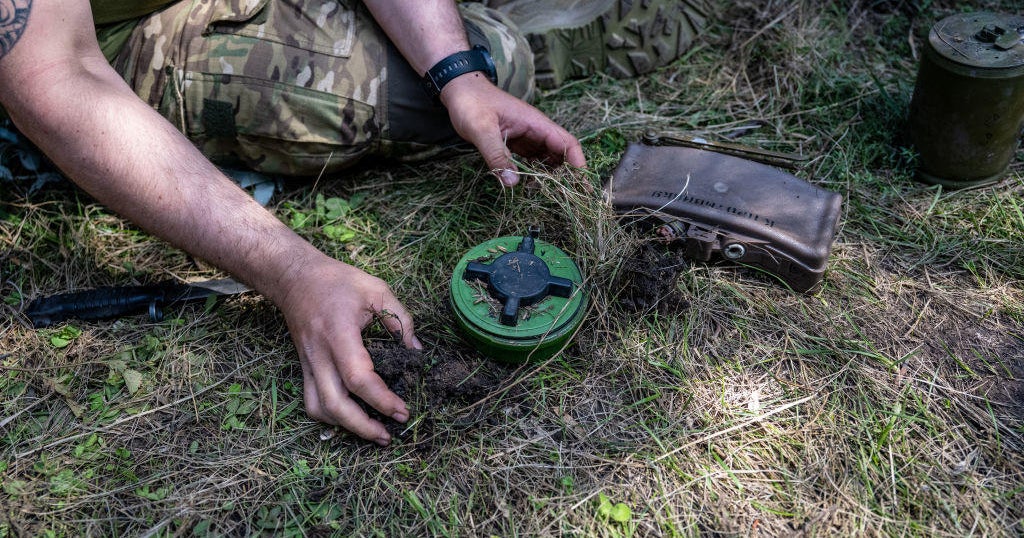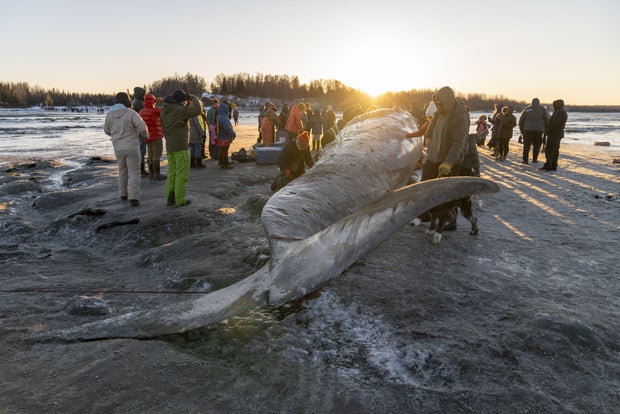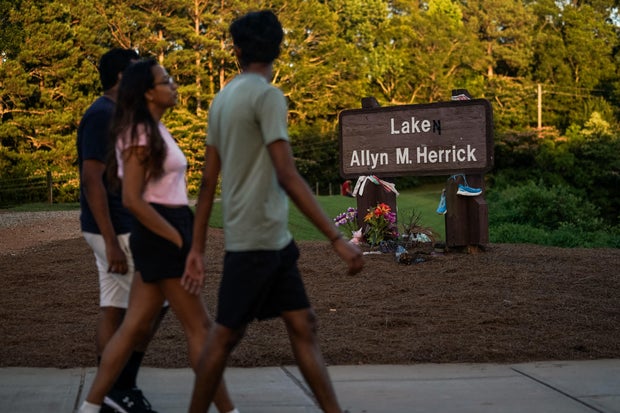CBS News
Ukraine’s civilians losing life and limb in landmine crisis: “It’s a real horror”

A Ukrainian man thought he’d cleared his garden after he and his wife found a dozen landmines. He was wrong.
There was a 13th landmine in Ihor Bogoraz’s garden at his summer home on the outskirts of Izium, one of the millions of landmines spread across Ukraine.
“I stepped on it and it exploded instantly,” he said in Ukrainian. “And that’s it — no leg.”
Since our visit, he’s received a prosthesis. His son is serving in the Ukrainian army. Bogoraz, a 61 year-old retired glassmaker, is one of more than 1,000 civilians wounded by mines in Ukraine, according to Ukrainian authorities. A massive effort is underway to find and remove the deadly weapons, but it will take a generation or more to be rid of them.
The victims of landmines in Ukraine
Serhii Nikolaiv was walking in leaves from the autumn while uncovering grapevines for the spring when he triggered a mine. If it had been green, he said he would have noticed it, but the mine was brown and blended in with the leaves.
“I stepped on it and I knew right away,” Nikolaiv said in Ukrainian.
Tragedy struck twice for Serhii Nikolaiv. His sister-in-law stepped on a mine in front of her children and was killed.
“Even now, someone could drop a fork or a spoon and it makes a loud noise. And in your soul, you feel pain, and bitterness, and fear. It’s a real horror,” he said.
Another victim, 70-year-old widow Lidia Borova, was out picking mushrooms in the forest when she came across a mine.
60 Minutes
“I turned by the tree and then there was an explosion,” she said in Ukrainian. “I looked [down] at myself and I was bleeding, my arm was injured, my leg was injured. I was losing strength.”
Her right foot and ankle were ripped away.
“I didn’t realize how much blood I lost,” she said in Ukrainian. “I don’t know how I managed to survive.”
Borova credits surgeon and Ukrainian hero Dr. Yuriy Kuznetzov with saving her life.
Dr. Kuznetzov, who remained in Izium during Russia’s six month occupation there said most of the victims he’s treated stepped on “petal” mines, or anti-personnel mines. The 5-inch-long mines flutter from the sky by the thousands, falling like flower petals. Eleven pounds of pressure will set them off.
“The person who invented them was an evil genius because they only weigh [2 ounces] but what they can do when triggered is terrifying,” Kuznetzov said in Ukrainian.
Healing the victims
Dr. Kuznetzov used to see landmine victims every week or so. Efforts are underway to clear the mines, in Izium and beyond but that will take years.
The doctor has devoted half his life to Izium’s Central Hospital. Many of his colleagues evacuated after the full-scale invasion began, but Dr. Kuznetzov, a native of Izium, stayed.
“When you have patients and you’re the only doctor or the only person who can treat them, I didn’t understand how you could leave,” he said in Ukrainian.
60 Minutes
About a week into the war, Izium’s Central Hospital was bombed, crippling medical services in the city. Russia’s six month occupation began a month later, and many civilians and medical staff fled. Dr. Kuznetsov stayed – and kept the hospital open.
“The best praise for me was when a woman told me in April of 2022 that ‘when we heard the hospital was still open, we realized that our town had hope, it could withstand, survive, and [have a] future,'” Dr. Kuznetzov said in Ukrainian.
Izium was liberated in September 2022. Russian occupation left more than 1,000 dead and 80% of the city destroyed. Today, Izium, just 20 miles from the frontline, is contaminated with mines and unexploded ordnance. Civilians there are losing limbs from anti-personnel mines still scattered throughout the city and the surrounding villages.
One of the most difficult tasks for Dr. Kuznetzov is persuading patients in the region that they need a leg amputated after a mine accident.
“It’s very difficult to explain to them that the leg is no good, no good to use,” he said.
Removing the mines
While Dr. Kuznetzov helps victims, demining teams are working to remove the landmines and unexploded ordnance in Izium and beyond.
When Vasyl Solyanik found petal mines on his roof and in his garden, he dialed 101 and emergency services sent deminers Ivan Shepelev and Ihor Ovcharuk to help. All over Ukraine, the pair have found every type of munition, Ovcharuk said: anti-infantry, anti-tank, mortars, artillery shells and rockets.
Shepelev said as the Ukrainians liberated occupied territory, the Russian military left booby traps and mines everywhere including in civilian homes. Ovcharuk said bodies of dead Ukrainian soldiers were mined.
60 Minutes
Demining work is dangerous. In 2022, a mine accident shattered Ovcharuk’s kneecap. Despite the dangers, the work continues.
“We know every explosive we remove means someone’s life is saved,” Shepelev said.
Pete Smith, who heads demining efforts for HALO Trust, a charity founded in 1988 to demine war zones, said today Ukraine is the most heavily mined country in the world.
“I think the scope is unrecognizable in modern times,” Smith said.
Smith took 60 Minutes correspondent Scott Pelley to a farm outside of Izium sown with Russian anti-tank mines. There Pelley met HALO deminer Yulia Yaroshchuk and watched as she used a slim wand to methodically search for tripwires in a large field with tall grass. On her knees next to a live landmine, Yaroshchuk used the wand to move the grass blade by blade. The day before our visit to the farm, a HALO deminer was killed and two others were wounded in southern Ukraine.
Pelley asked Yaroshchuk why she continues to do such dangerous work.
“This is my contribution to victory,” she said.
CBS News
Woman linked to 14 cyanide murders is convicted and sentenced to death in Thailand

A Thai woman believed to be among the worst serial killers in the kingdom’s history was convicted and sentenced to death Wednesday for poisoning a friend with cyanide, in the first of her 14 murder trials.
Sararat Rangsiwuthaporn, 36, an online gambling addict, is accused of swindling thousands of dollars from her victims before killing them with the chemical.
A court in Bangkok convicted her Wednesday for fatally poisoning her friend Siriporn Kanwong.
The two met up near Bangkok in April last year to release fish into the Mae Klong river as part of a Buddhist ritual.
Siriporn collapsed and died shortly afterwards and investigators found traces of cyanide in her body. Last year, police said they collected fingerprints and other evidence from Sararat’s Toyota Forerunner.
LILLIAN SUWANRUMPHA/AFP via Getty Images
Police were then able to link Sararat to previously unsolved cyanide poisonings going back as far as 2015, officers said.
“The court’s decision is just,” Siriporn’s mother, Tongpin Kiatchanasiri, told reporters following the verdict. “I want to tell my daughter that I miss her deeply, and justice has been done for her today.”
Police said Sararat funded her gambling addiction by borrowing money from her victims — in one case as much as 300,000 baht (nearly $9,000) — before killing them and stealing their jewelry and mobile phones.
She lured 15 people — one of whom survived — to take poisoned “herb capsules,” they said.
Sararat faces 13 more separate murder trials, and has been charged with around 80 offenses in total.
Her ex-husband, Vitoon Rangsiwuthaporn — a police lieutenant-colonel — was given 16 months in prison and her former lawyer two years for complicity in Siriporn’s killing, the lawyer for the victim’s family said.
The couple, while divorced, had still been living together, the BBC reported. Police said Rangsiwuthaporn was likely involved in Sararat’s alleged murder of an ex-boyfriend, Suthisak Poonkwan, the BBC reported. Police said that after she killed him, Rangsiwuthaporn picked her up in her car and helped her extorte money from Suthisak’s friends.
Thailand has been the scene of several sordid and high-profile criminal cases.
Earlier this year, six foreigners were found dead in a luxury Bangkok hotel after a cyanide poisoning believed to be connected to debts worth millions of baht.
CBS News
Endangered fin whale measuring nearly 50 feet found dead near Anchorage, drawing curious onlookers to beach

An endangered fin whale that washed up near a coastal trail in Alaska’s largest city has attracted curious onlookers while biologists seek answers as to what caused the animal’s death.
The carcass found over the weekend near Anchorage was 47 feet (14.3 meters) long – comparable to the width of a college basketball court – and female, according to National Oceanic and Atmospheric Administration biologists.
Barbara Mahoney, a NOAA biologist examining the whale, told the Anchorage Daily News the whale was likely 1 to 3 years old.
Fin whales are the second-largest whale species, according to NOAA Fisheries, and fully grown can reach up to 85 feet long and weigh between 40 tons and 80 tons. Strikes by ships, entanglements in fishing gear, underwater noise and the effects of climate change are among the threats that fin whales face, according to the agency.
Hasan Akbas/Anadolu via Getty Images
Mandy Keogh, a NOAA marine mammal stranding coordinator, said fin whales generally aren’t seen this close to Anchorage and that recent high tides may have pushed the animal further into the Knik Arm.
People trekked across the mudflats to see the whale, which NOAA biologists and staff from Alaska Veterinary Pathology Services had anchored to the shore Sunday so they would be able to gather samples from the animal. But even after samples are analyzed, it can be difficult to determine a cause of death because of decomposition or a lack of obvious injuries, Keogh said.
Daisy Grandlinard was among the parents who accompanied a group of children to see the whale Monday. As they drew closer, they could smell it, she said.
“It was really interesting for the kids to be able to feel it, touch the bottom because it kind of had tracks on it, like a sled almost. And just to see the size of it, that was pretty cool,” she said. “We had already studied whales a couple of weeks ago, so it was fun to see one in person and say, ‘Oh, that’s what the baleen looks like in real life,’ and ‘Where is the blow hole?’ “
Biologists hoped to complete their work Tuesday, untether the carcass and “let the tide push it or move it,” Mahoney said. “Whatever it does or doesn’t do – we don’t know.”
According to NOAA, the whaling industry killed nearly 725,000 fin whales in the mid-1900’s in the Southern Hemisphere alone. Today, the major threat to the species comes from vessel strikes.
Other fin whales have washed ashore along the Western U.S. this year. In August, a large fin whale washed ashore in Southern California and died before rescuers could get to the scene, CBS Los Angeles reported. Officials said the whale, which was not fully grown, was believed to be in poor health due to visible bumps on its skin and a thin build.
In February, a 46-foot-long whale was found washed up on an Oregon shore — emaciated, entangled and covered in what appears to be wounds from killer whales.
CBS News
How Laken Riley’s death sent “a reality shock” through the college town of Athens, Georgia

Just two blocks from the University of Georgia campus, in a downtown courtroom in Athens, Georgia, Jose Ibarra is on trial for the murder of 22-year-old Laken Riley, a former UGA student who transferred to the nursing program at Augusta University’s Athens campus.
In late February, Riley was attacked during her morning jog on a trail near the University of Georgia’s intramural fields. As the investigation and trial unfolded, members of the Athens community grappled with a shaken sense of security.
“Just because we’re on campus doesn’t mean, necessarily, that the bad parts of the world can’t get in,” said Allison Mawn, a fourth-year student. “She did everything right. She told friends where she was going, she went on a popular trail during the day. She had her tracking location on. She even managed to call for help, and still it wasn’t enough.”
The case was thrust into the national spotlight when authorities arrested Ibarra, an undocumented Venezuelan immigrant who entered the country two years ago, and charged him with murdering Riley. In the midst of the election cycle, her death quickly became a flashpoint in the immigration debate, with former President Donald Trump and his supporters raising it at rallies and President Biden responding to heckling about it in his State of the Union address.
“In an instant, all the eyes across the country are on us,” said Mawn. “Now you can’t say the name Laken Riley without thinking about undocumented immigrants and illegal immigration.”
ELIJAH NOUVELAGE/AFP via Getty Images
Students have organized vigils and prayer groups, and participated in protests, rallies and runs in memory of Riley. A GoFundMe set up by her family amassed over $250,000 in donations that will go to the Laken Hope Foundation, an organization that will “promote safety awareness for women, aid and tuition assistance for nursing students, and children’s healthcare… all causes that Laken felt strongly about.”
For many students, Athens no longer feels like the safe haven they once thought it was. To ease fears, University of Georgia President Jere Morehead announced a $7.3 million campus safety initiative. The campus has been fortified by an expanded university police force, hundreds of additional lights and security cameras and multiple emergency call stations and license plate readers.
ELIJAH NOUVELAGE/AFP via Getty Images
Over the past months, “there was an expectation that we would magnify those efforts,” said P. Daniel Silk, the University of Georgia’s associate vice president for public safety. “We want to be more safe and more secure tomorrow than we were yesterday.”
While the Athens community waits for justice to be delivered, students bustle around campus, walking under the newly installed street lights, passing by additional emergency call systems and easing into a heightened security presence. Classes may go on, but the campus and community are changed.
“Regardless of what the verdict is, unfortunately we still lost a student. We still lost a life and nothing’s gonna change that,” said Mawn. “Things are never going to be a hundred percent the same for any of us here.”















